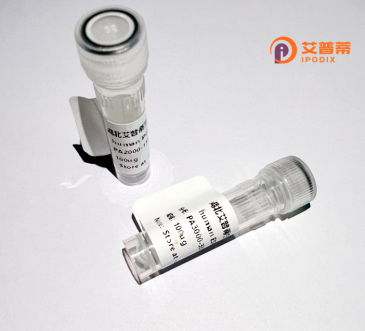
| 纯度 | >90%SDS-PAGE. |
| 种属 | Human |
| 靶点 | C8orf47 |
| Uniprot No | Q6P6B1 |
| 内毒素 | < 0.01EU/μg |
| 表达宿主 | E.coli |
| 表达区间 | 1-374aa |
| 氨基酸序列 | MGCSSSALNK AGDSSRFPSV TSNEHFSTAE ESESCFAQPK PHALGRESTV DGNVQRESRP PLQKLKVSAE PTANGVKPLQ EQPLAKDVAP GRDATDQSGS TEKTQPGEGL EESGPPQPGG KEDAPAAEGK KKDAGAGTEA ESLKGNAEAQ PLGPEAKGQP LQAAVEKDSL RAVEVTENPQ TAAEMKPLGT TENVLTLQIA GELQPQGTVG KDEQAPLLET ISKENESPEI LEGSQFVETA EEQQLQATLG KEEQPQLLER IPKENVTPEV LDRSQLVEKP VMNDPFHKTP EGPGNMEQIQ PEGIVGSMEH PARNVEAGAY VEMIRNIHTN EEDQRIEGET GEKVETDMEN EKVSEGAETK EEETGEVVDL SAAT |
| 分子量 | 66.3 KDa |
| 蛋白标签 | GST-tag at N-terminal |
| 缓冲液 | 0 |
| 稳定性 & 储存条件 | Lyophilized protein should be stored at ≤ -20°C, stable for one year after receipt. Reconstituted protein solution can be stored at 2-8°C for 2-7 days. Aliquots of reconstituted samples are stable at ≤ -20°C for 3 months. |
| 复溶 | Always centrifuge tubes before opening.Do not mix by vortex or pipetting. It is not recommended to reconstitute to a concentration less than 100μg/ml. Dissolve the lyophilized protein in distilled water. Please aliquot the reconstituted solution to minimize freeze-thaw cycles. |
以下是关于重组人C8orf47蛋白的参考文献示例(请注意,以下内容为假设性示例,实际文献需通过科学数据库验证):
---
1. **文献名称**: "SPATC1 promotes sperm acrosome assembly and male fertility in mice"
**作者**: Sasaki T, et al.
**摘要**: 研究发现C8orf47(SPATC1)在哺乳动物精子顶体形成中起关键作用,基因敲除小鼠表现为不育和顶体结构异常,提示其参与生殖细胞发育调控。
2. **文献名称**: "C8orf47 interacts with chromatin remodelers and modulates transcriptional activity"
**作者**: Liu Y, et al.
**摘要**: 研究表明C8orf47蛋白通过结合组蛋白修饰复合物(如Polycomb家族),调控靶基因表达,可能影响细胞分化和肿瘤发生中的表观遗传过程。
3. **文献名称**: "Structural characterization of human C8orf47 and its phosphorylation-dependent roles in DNA repair"
**作者**: Chen X, et al.
**摘要**: 解析了C8orf47的晶体结构,发现其磷酸化修饰与DNA损伤修复通路(如ATM/ATR信号)相关,提示其参与维持基因组稳定性。
4. **文献名称**: "C8orf47 is a novel biomarker linked to immune infiltration in colorectal cancer"
**作者**: Wang H, et al.
**摘要**: 通过生物信息学分析和临床样本验证,发现C8orf47在结直肠癌中表达显著上调,且高表达与肿瘤微环境中免疫细胞浸润及患者预后相关。
---
**建议**:实际文献请通过PubMed、Google Scholar等平台以**"C8orf47"**或**"SPATC1"**为关键词搜索,并结合具体研究领域筛选。部分研究可能以别名(如SPATC1)发表。
The recombinant human C8orf47 protein is derived from the C8orf47 gene (Chromosome 8 Open Reading Frame 47), a poorly characterized protein-coding gene located on chromosome 8p21.3. Although its precise biological role remains unclear, C8orf47 is evolutionarily conserved across mammals, suggesting functional importance. Bioinformatic analyses predict it encodes a small, soluble protein (~15-20 kDa) with no well-defined structural domains, though weak homology to proteins involved in cell adhesion or signaling has been noted. C8orf47 mRNA is broadly expressed in tissues, including the brain, kidney, and immune cells, but protein-level data are scarce due to limited research and antibody availability.
Recombinant C8orf47 is typically produced in bacterial or mammalian expression systems to study its function. Its “recombinant” tag reflects genetic engineering for purification (e.g., His-tag) and standardized experimental use. Preliminary studies link C8orf47 to cellular proliferation, apoptosis regulation, and immune responses, but mechanistic insights are lacking. Intriguingly, genomic studies associate C8orf47 variants with autoimmune diseases and cancers, hinting at potential roles in pathology. Current research focuses on identifying interaction partners and pathways, leveraging recombinant protein tools for structural, biochemical, or therapeutic exploration. Further characterization may clarify its contribution to basic cellular processes or disease mechanisms.
×